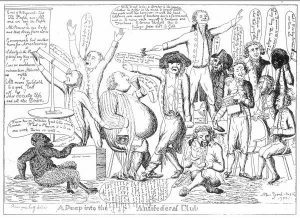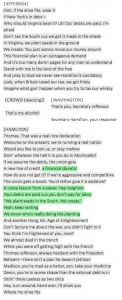This post is by Alec Stutson, a student in Dr. Megan Peiser's English 2100 class. Dr. Peiser brought her class to Special Collections several times over the course of the semester to work with materials illustrative of the history of books and reading. Alec worked with a collection of American and British pamphlets related to the musical Hamilton. He can be reached on Twitter at @padawanovelist.
Culture is a constantly shifting and hard to define concept. Changes in language, styles, and the ever-tumultuous nature of world news and politics leads to cultures that are constantly in flux, reacting and incorporating new elements. When it comes to literary theory, culture plays a large part in how literature is interpreted and discussed. In Critical Theory Today: A User-Friendly Guide by Lois Tyson, Tyson outlines a particular school of thought, called Cultural Criticism, which deals directly with the ways that a culture interacts with, reacts to, and interprets not only literature, but real-world events. Cultural Criticism believes that “human history and culture constitute a complex arena of dynamic forces” and that “individual […] selfhood develops in a give-and-take relationship with its cultural milieu: while we are constrained [by our culture …] we may struggle against those limits and transform them.” This means that through the lens of Cultural Criticism, we may analyze works not only on their own merits, but how they influence and pull from the culture in which they were created. Of all the popular works of literature in recent memory, none lend themselves as well to this theoretical approach as Hamilton, the hip-hop musical by Lin-Manuel Miranda about America’s “Ten-dollar Founding Father,” Alexander Hamilton. In Miranda’s smash-hit musical, he tells the story of Alexander Hamilton, from his unlikely upbringing to his early death at the hands of his lifelong frenemy, Aaron Burr. However, Miranda doesn’t do this in the usual, song-and-dance show-toon fashion. Instead, he tells the story through Hip-Hop. Think less Les Misérables, more Jay Z. Further more, modern pop-culture has taken the language and references of Hamilton, and incorporated them, where they have taken on a life of their own as memes and inside-jokes on social media platforms like Tumblr and Twitter. Let’s take a look at how the issues facing Alexander Hamilton were interpreted by his contemporary culture, how Lin-Manuel Miranda told those stories through Hip-Hop, and how modern internet culture has embraced the musical, and injected it into its own vocabulary.
The conflict underlying the first example is the fierce debate that raged between the Federalist and Anti-Federalist parties. During the foundational years of the US, there was much debate over how the country should be structured and run into the future. It is easy for us moderners to forgot that the laws and inner working of our country were not always so set in stone. America started out as a great experiment, it took many years and heated cabinet meetings to lay the groundwork that allows our country to survive and thrive. The Federalists, headed by Alexander Hamilton and George Washington, were mostly urban citizens, who believed that there should be a powerful central government that focused on economic regulation. Hamilton was a particularly strong supporter of a central bank. The Anti-Federalists on the other hand, were mostly rural, and wanted the states to operate as independent bodies who should handle their money and economies as they saw fit. This movement was mostly lead by Thomas Jefferson, whose disagreements with Alexander Hamilton were infamous, and are the groundwork for the next three items I’m going to analyze.
This is a political cartoon originally published in 1793, titled “A Peep into the Antifederal Club”. An attack cartoon against the anti-federalists, who were Alexander Hamilton’s political enemies, it depicts party leader Thomas Jefferson, rallying a rag-tag group of undesirables, including Satan himself. “What a pleasure it is to see one’s work thrive so well,” the devil says, looking at the group. Other members depicted include an obese drunk who damns the federal government, and a greedy money-counter sitting underneath Jefferson. All the while, Jefferson looms over like a cult leader, spouting mock-shakespearian prose about knocking over the federal government. At this point in history, this debate was imminent. It’s easy to look back at the values of both the Federalists and Anti-Federalists, and see what worked and what didn’t. But in 1793, this was a battle for the soul of the country. Both sides believed that America would live or die based on what policies were enacted.
This cartoon gives a lot of insight into the values of the culture at the time, especially by looking at the charicatures that are presented. The most notable inclusion in the Antifederal club is that of Satan. The late 18th century was a deeply religious time in US History, with the majority of political players and voters being Christian. Portraying Jefferson and his cohorts as Atheistic or even worse, Devil-worshipping, was a massive character asassination. The artist goes so far as to say that the work of the party is the work of the devil himself. The american people at the time were so deeply religious, this would be comparable to satire today comparing the president to a terrorist leader. The inclusion of satan not only exposes the vitriol present in the political discourse at the time, but leads insight into the core values of American society at the time.
Up next is an excerpt from “Cabinet Meeting #1” in Lin-Manuel Miranda’s musical Hamilton. In it, the debate between Hamilton’s Federalist beliefs and Jefferson’s Anti-Federalist beliefs rage on in the form of a good ol’ fashioned Rap Battle, complete with mediator George Washington, and rowdy reactionary crowd made up of the other cabinet members. This retelling of political debate is a fascinating stylistic choice, and one of the many reason why Hamilton is so brilliant. Miranda takes policy debate about taxation and economics, which could easily have been boring or glossed over all together, and makes it into a highpoint of the musical, both lyrically and in terms of character development. Miranda weaves real-world allusions, such as Britain’s controversial tea taxation, and Hamilton’s proposed taxation of whiskey, into a catchy burn delivered by Jefferson. By translating a cabinet meeting into a rap battle, a concept brought into popularity by the movie 8 Mile, and the mega-popular YouTube channel “Epic Rap Battles of History”, Miranda not only engages the audience, but he translates the significance of these debates at the time into a language that is understandable by modern audiences.
Rap battles are confrontational by nature. Two rappers are pitted against one another and tasked with assaulting each other with insults that are both effective and lyrically clever. This contentious and adversarial nature mimics the passion with which Hamilton and Jefferson debated during the cabinet meetings. While this Intensity can often be lost in textbooks and history classes, Miranda makes it tangible through his interpretation. Additionally, rap battles have a winner and loser, decided by the crowd’s response and occasionally a judge. This ties into the nature of politics at the time as well. In the Federalist and Anti-federalist debates, one side had to emerge victorious, and it was up to Jefferson and Hamilton to not only convince Washington (the judge of the battle), but also to convince the other members of the cabinet to back them with votes (represented by the crowd’s reactions to the rappers insults). If Hamilton had a particularly compelling argument, Miranda portrays that as a clever and savage rhyme. If it gained a lot of traction with other cabinet members, that is shows through their reactions on stage. By translating this discussion to battle-rap format, Miranda is effectively able to convey important concepts and draw parallels, without losing any of the catchy-ness or wit present throughout the musical.
Cabinet Battle #1
Hamilton: Keep ranting, WE KNOW WHO'S REALLY DOING THE PLANTING pic.twitter.com/OqkFc26hxc— bumblesnoot (@cadymiddleton) March 28, 2017
The final example to consider is this tweet by Twitter user @Cadyphippsie. This tweet is a step further removed from the federalist and anti-federalist debate that inspired Miranda, but it still offers an interesting look into the way that the internet incorporates concepts and other media into its own vernacular, and combines them using its own unique language, symbols, and implied meanings. From an outside, perspective, the tweet might not make a ton of sense. Sure, it can be assumed that the crowd is reacting to something, and that the smug looking character in the middle is the center of attention, but there is actually a little bit more going on behind the scenes.
The gif is taken from this sketch-parody YouTube video uploaded in 2013, called “The Rap Battle”. At the time of writing, the video is sitting pretty at over 13 Million views. The video is of a rap battle, where on participant is barely rapping, bur receives extremely exaggerated reactions from the crowd, while his opponent, who has some solid bars, can barely hold their attention. The video is funny, and gained a lot of traction based on its humor alone. However, the above gif was lifted from it, and began to see a rise in popularity as a reaction image: an image of gif used to express a reaction. Reaction images often have some sort of connotation associated with them, and they often serve as internet inside-jokes. The clip from Rap Battle became synonymous with a sick burn or savage insult. That’s precisely how it comes into play within the context of this Hamilton-related tweet.
Not only is @Cadyphippsie acknowledging Miranda’s lyrical genius, but the gif almost serves as an endorsement of the message. The fact that these lyrics were chosen shows how they have resonated with modern audiences. While researching this post, I found numerous tweets and posts that were about “Cabinet Meeting #1”, and these particular lyrics condemning Thomas Jefferson’s use of slave labor popped up often. The gif has turned not only into shorthand for “look at this sick burn”, but by extent it reflects the agreement with the sentiment of the lyrics. On the Genius.com page for “Cabinet Meeting #1”, Miranda himself comments on these particular lyrics, saying “This line actually feels like we’re in a time machine and we actually get to speak truth to the real Jefferson — things that we could never say to him. […] He really participated in this brutal system. So this moment is really cathartic.” Miranda felt a sense of catharsis and gratification in writing these lines, and that obviously resonated with internet-savvy listeners. But rather than saying “I agree with Lin-Manuel Miranda”, Twitter users endorsed it in their own way, using a language of memes and instant-sharing that only could be communicated on the internet. In this way, the reaction image becomes more than a joke, and in a way reflects the values and mindset of modern society.
Thus, the battle between the Federalists and Anti-Federalists still sees attention and humor even today, although in a different form. As I said mentioned at the beginning, cultures are complicated, and the way they interact with media is incredibly complicated, and ever-changing. Whether it was religious symbolism, Hip-Hop throw-downs, or animated gif reactions, three complex cultures reacted to two complex men in their own special way that gives insight into their cultural values, traditions, and interests. And while many “classical” scholars might dismiss a meme or cartoon as low-brow and unworthy of analysis, cultural criticism shows that even these things can provide insightful analysis, and are worthy of attention and critique. It just goes to show that Satan, Rap Battles, and Twitter might have more in common than you might think.


